
- Stunt Kites
- Single Line Kites
- Power Kites
- Revolution Kites
- Kite Flying Line
- Kite Stakes
- Kite Winders & Reels
- Kite Buggies
- Mountainboards

Landsailers
- Wind Gauges
- Wind Powered Vehicles
- Manta Landsailers
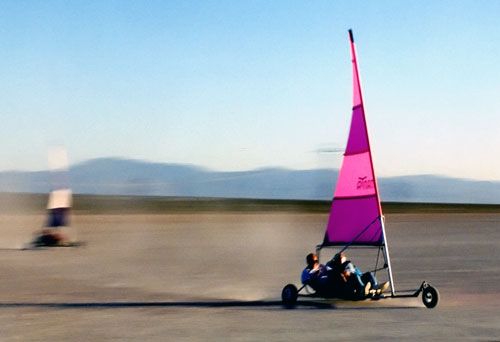
Manta Landsailer
Where to Buy
- A Wind of Change
- Specifications
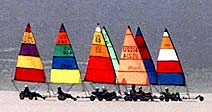
The single-seat WinJammer landsailer and the two-place TwinJammer landsailer are the land yachts that revolutionized landsailing. These wind powered vehicles use the materials and design concepts of ultra-light gliders, Manta has created landsailers so light, yet so rugged and potent. They give high performance landsailing on any hard, flat surface - your local parking lot, beach, dry lake bed , or field. Using the natural free energy of the wind, you can accelerate quickly to over twice the speed of the wind! The current landsailing speed record is 126.1 mph , set March 27th 2009 on the Ivanpah dry lake bed 45 minutes outside of Las Vegas.
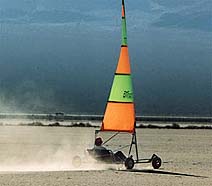
The Manta can be set up for landsailing action in 5 minutes. The ultra-lightness is revolutionary because it permits exciting operation even in small areas. The WinJammer weighs just 70 lbs, with a fully battened sail of 45 sq/ft and a turning radius under 6 feet. The TwinJammer weighs 105 lbs, carries 59 sq/ft of sail and has a turning radius of 8.5 feet. The incredible acceleration and maneuverability let them make the most of any site.
For more information on the sport of landsailing please visit the North American Land Sailing Association and check out the article on landsailing and kite buggies in the Las Vegas View . For more pictures please visit our Landsailing Picture Gallery . Need TwinJammer parts or WinJammer parts for your Manta Landsailer? We can get them for you.
Manta landsailers come complete. The only upgrades are a reinforced rear axle, a hex ratchet block and bracket. These upgrades are strongly recommended.
Manta Landsailer Specifications
Manta landsailing video.
Manta Landsailer Photos
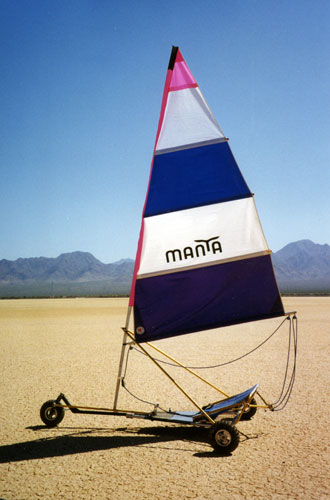
Manta TwinJammer Two Seater
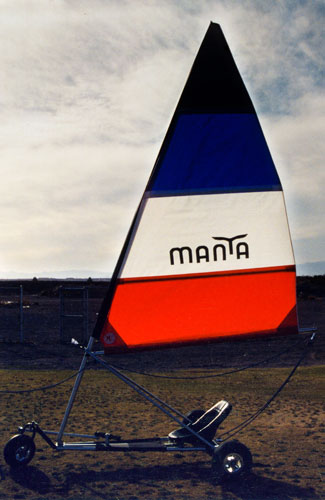
Manta WinJammer Single Seat
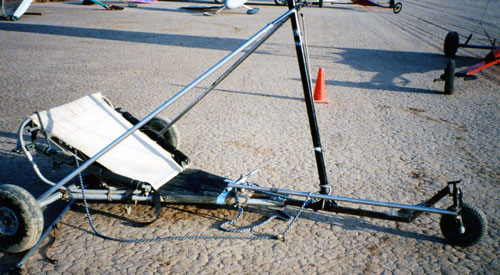
Pilot's View from a Landsailer.
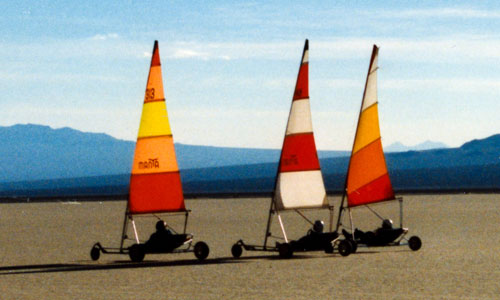
Manta TwinJammer (Left) and WinJammer (Right)
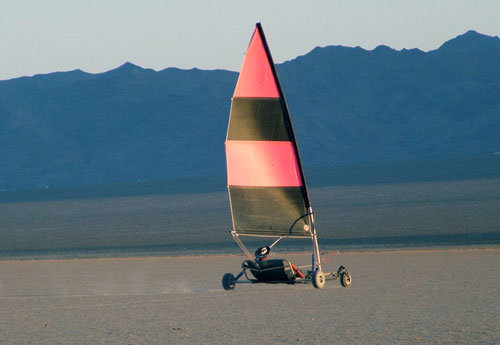
Kite Flying How to Guides
- Best Places to Go Fly a Kite
- Stunt Kite Flying Guide for Beginners
- Stunt Kite Trick Video Guide
- Power Kite Basic for Beginners
- Single Line Kite Guide
- How to Use a Kite Winder
- Kite Buggy Guide
- Flying the Revolution
- Fighter Kite Flying Guide
- Kite Aerial Photography Guide
- Kites and Kids
Photo Galleries
- Stunt Kite Pictures
- Single Line Kite Pictures
- Kite Buggy Pictures
- Landsailer Pictures
Kiting Resources
- Ivanpah Dry Lake
Copyright © 1999 — 2022 WindPower Sports | Privacy Policy | Contact Us

- Things To Do
How to Turn a Desert Vacation Into a Sailing Adventure (Minus the Boat)
No water no problem..
Published on 9/29/2022 at 5:33 PM
Spend some time at Ivanpah Dry Lake , nestled in the northern end of the Mojave National Preserve about 30 minutes from Vegas, and you might start to see things. Here on the Pleistocene playa, the lake bed is cracked yet coated with a smooth sheen; the post-apocalyptic setting of mountain-fringed nothingness both dusty and, in the clashing temperatures, veiled with a watery mirage. So much so that when you see the land yachts—curious three-wheeled wind-powered buggies slicing through the nothingness with shark-like fins—you might believe they’re actual sailboats.
And depending on when you visit, you may even spot an influx of boats that don’t float. Because unlike other dry lake beds in the area—utilized year-round for everything from off-road adventures to camping to art-festival shenanigans to filming movies like Casino —the Bureau of Land Management takes measures to preserve Ivanpah for the use of non-motorized wind craft. It’s thus considered one of the smoothest landsailing courses in the world, akin to ice boating’s frozen lakes. And with winds gusting up to 50 miles per hour, it’s a regular destination for adrenaline junkies participating in elite regattas like the America’s Land Sailing Cup , a multi-vehicle competition put on by the North American Land Sailing Association, as well as the solo-style Blokart Worlds (it rhymes with go-cart).

It was here in Ivanpah that British engineer Richard Jenkins set the record for land yachting, reaching a whopping 126.1 miles per hour in the sleek alien-like Ecotricity Greenbird , which favored a carbon airplane-like wing over a sail (land yachts indeed come in all shapes and sizes). It was also here that the latest Blokart record was set, tied by two competitors—AKA pilots—in 2018.
“They were out on the playa and they looked at each other and could see one of those dust storms coming their way,” says Andrew Sands, co-owner of Bonaire Landsailing Adventures and an internationally-ranked pilot himself. “They gave a thumbs up that they were gonna take their chances and keep on sailing.” That day, Scott Young from Arizona and Dave Lussier from Rhode Island both defied the odds by clocking in at a record 77.7 miles per hour—all with their bums hovering just a few inches off the ground.
Before a couple of months ago , I’d never even heard of land sailing, let alone seen a yacht on wheels. But then I found myself in the breezy Dutch Caribbean island of Bonaire, watching the wind-powered go-karts whip around and around a rubbly oval track. Here, some riders could care less about speed. And why would they, when the scenery beckons you to relax? To the right, the sea splashed high up against rocks, while on the left, a bored donkey stood, grazing near cacti. Every so often, an iguana would cross the track. “I’m pretty sure there’s an iguana brothel on the center of the track at the top there,” says Donna Hudgeon, co-owner of the company and Sands’s wife. “I’d be surprised if you hadn’t seen an iguana.”
Though it’s the first time the sport and I have crossed paths, some iteration of land sailing has been around pretty much since wheels became light enough to be mobilized by wind power. There’s evidence Ancient Egyptians tooled around on their version of the vehicle, while texts and paintings suggest that the Ming Dynasty was rife with carriages equipped with sails. During Westward Expansion in the 19th century, the US had their own wind-powered carts, including—in true American style—one resourceful entrepreneur who attempted to bypass horses and harness the wind for profit, using it to transport passengers over the rolling plains. It failed on its maiden voyage, but he still earned an enviable nickname: Wind Wagon Thomas.

In 1898, a pair of Belgian brothers created what is regarded as the first-ever recreational land yacht, followed by the first competition in Belgium in 1909. Increased vehicle production led to land yachting clubs springing up on the beaches of France in the 1950s. While the rest of the world typically powered their sand buggies with ocean breezes, when the US got in on the action about a decade later , it prompted a convergence of individualist inventors intent on making good use of the country’s ample dry lake beds and rugged deserts. Today, the sport goes by a slew of monikers around the world, tailored to the countries that practice them and the terrain they race: From sand sailing to land yachting, beach sailing, wind karting, char à voile (France) and carrovelismo (Argentina). The most illustrious? Dirt boating . That one’s all American.
In the US, you’re probably most likely to encounter the homegrown Manta Landsailer , first produced in 1974 in Oakland, California. But in Bonaire, the vehicles of choice are Blokarts —also with its own verb, blokarting— a relative newcomer in the history of the sport and perhaps the easiest for a beginner to navigate. The buggies were created in 1999 when Paul Beckett, an avid land sailor and hang glider, wanted to create a more accessible toy that allowed everyday consumers to zip around the beaches of New Zealand.

Unlike the Manta, which you steer with your feet, Blokarts only require your hands for both steering and adjusting the sail , making it adaptable for a variety of users including paraplegics and lower extremity amputees. The karts also fold up neatly into a suitcase for transport, and are easily assembled once you’re ready to hit the sand. Throw it in your trunk and take it to the beach, or check it at the airport for your competition at Ivanpah. Sails come in four sizes and the whole rig starts at around $4,000 each.
“New Zealanders tend to be very inventive, DIY kind of people. There were versions of land yachts out there, but nothing that was repeatable, just something someone put together in their garage,” says Hudgeon. “So when Blokart hit the scene, that was it. Everyone just jumped onto it like ‘Hey, this is super easy.’”
For one half of the Bonaire Landsailing Adventures husband-wife team, it was definitely love at first sight. “Paul sent me out on the track with his Blokart to give it a try, and he had to come out at the end of the day to collect me,” recalls Sands. “I was still sailing around the track.”
Today, Blokart is sold in 27 countries, including Bonaire. Already a go-to for kitesurfing and wind sailing (Bonaire is a breeding ground for some of the world’s top windsurfers), opening a land sailing venture on the island seemed like a natural fit. Hudgeon and Sands looked at wind profiles—the space had to be flat and breezy year-round—but what clinched it was the personality of the island itself.
“The thing about Bonaire, is that the people that come here aren’t necessarily the kind that want to bob around on a beach,” says Hudgeon. “They’re doing people. They’re active.”

That is exactly what I’m there for: to do. Sporting my helmet and a pair of provided gloves, I half-listen to the debriefing—things like pull the rope to speed up, let it out to slow down, have fun. But watching participants circle the track in their little papooses, I get a little nervous. The truth is, I’ve never been good on wheels. In fact, I think the word once used to describe my driving skills was “nuisance.” Apparently, if you have sailing experience and know your tacks from your jibes, that can help. I don’t, but I’m assured no experience is necessary.
“We get all types,” says Hudgeon. “The hotshots who are like ‘Whoa this is a lot more fun that I thought it would be,’ the nervous people who are proud of themselves that they’ve done something that they didn’t think they could do, and the grandmothers that show up and say there’s no way they’re gonna go out there, that they’re just there to take the photo.” Yet after some convincing, those grandmas get out on the track and it’s an entirely different story: “They realize how easy it is and how much control they have, and it’s just so funny to see them out there egging on and racing the grandkids.”
The trick, I later find out, is to start off cautiously, getting to know the track over a couple of revolutions before getting fancy. The point is to feel the nuances of the wind and the sensitive adjustments to the rope. If you lose steam and get stuck, no big—someone will be there to push you back in. It’s pretty much idiot-proof. Unless, of course, you try to do too much, too soon.
I witness this as a guy—a “hotshot,” Hudgeon would say—comes speeding too fast around a turn, trying to overtake a buddy. He goes up on two wheels and promptly tips over. Luckily, he remembered to keep his elbows inside the steel cage—something else we’re told in the debriefing. After checking him out, Hudgeon finds the only thing bruised is his ego.

To get started with land sailing, you don’t need to buy your own vehicle just yet. Donna advises finding a club or course near you via the North American Land Sailing Association , Blokart’s website, or the International Sand Yachting Federation . They’ll usually have one on hand you can try out. Through these sites, you’ll also find retailers and plenty of ways to link up with like-minded adventurers.
I make a note to check it out when I get back home—New York and New Jersey have a few club locations that look promising. Back on the course in Bonaire, though, it takes just a few laps, including a little bit of stalling and a lot of bumping into the tires lining the course, but I eventually get the hang of it. The only obstacle I can’t avoid? A resident iguana leisurely snaking his way across my path.
Want more Thrillist? Follow us on Instagram , Twitter , Pinterest , YouTube , TikTok , and Snapchat !

Land Sailing in Nevada
January – february 2013.
- Previous Article
- Table of Contents
- Next Article
By MATTHEW B. BROWN
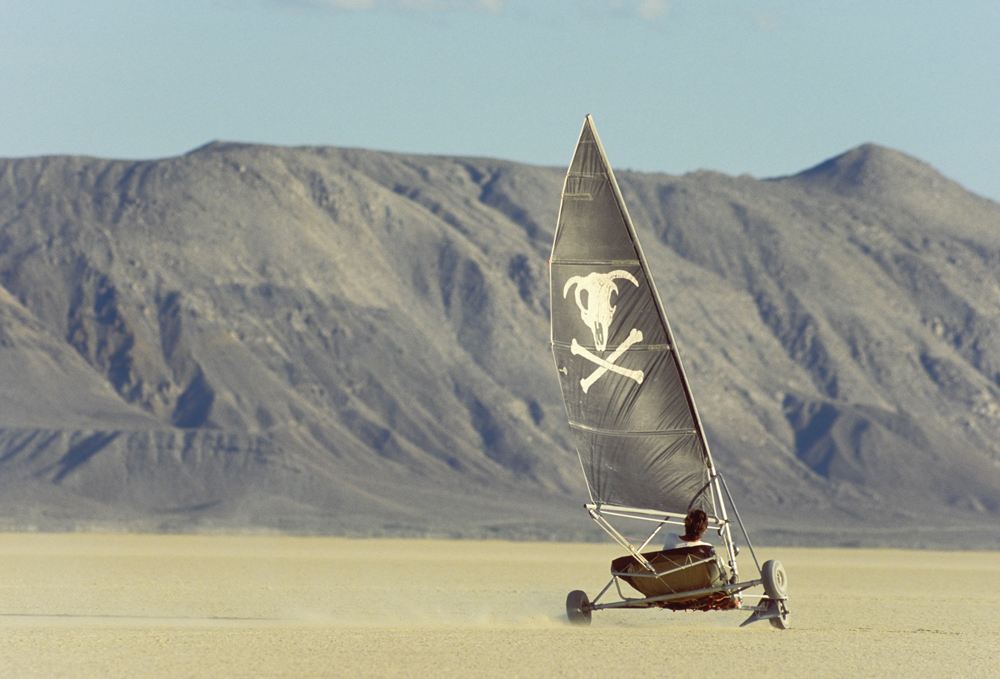
Nevada has many claims to fame, and you can add one more to the list: land sailing. In fact, I was interested to learn recently that the Silver State is arguably the premier land-sailing destination in the United States.
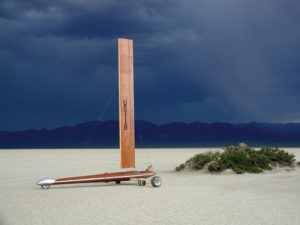
“We have the dry lakebeds, the hard mud,” says nine-time national champion and current treasurer of the North American Land Sailing Association, Mark Harris. “Nevada is a very popular location because we can go the fastest.” Nevada also has wind galore, which is as valuable to a land sailor as fuel is to a racecar driver.
Land sailing, also known as sand yachting or land yachting—or as Harris likes to call it, “dirt boating”—has evolved primarily into a racing sport in the last half century. Its roots can be traced as far back as 6th-century China. Centuries later, some European royalty used land yachts for entertainment, and they were even used hundreds of years ago in the U.S. to transport goods.
Today, however, they are used primarily for competition. Land-sailing events are held internationally from the vast beaches of Western Europe, Ireland, New Zealand, and Brazil to the dry deserts of the U.S. It’s no surprise then that the arid sands of Nevada have become the epicenter of the fiercely competitive dirt-boating world.
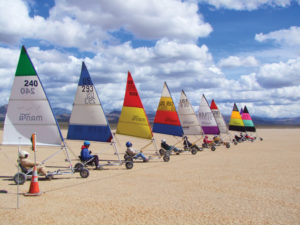
OK, maybe that’s a bit of an exaggeration. “It’s friendly competition,” says Harris, an electrical engineer for the Public Utilities Commission of Nevada. “The Europeans are big on entertainment, so that tradition has carried over to the states.” The sense of community and family is strong in land sailing. Harris says a group of spectators and racers, which rarely exceeds 100 at most events, will enjoy potluck dinners, fly remote-control airplanes, hold stargazing parties, and socialize around bonfires.
The next major Nevada event is America’s Landsailing Cup (this and most others are open to the public) on March 23-30 at Ivanpah Dry Lake, just south of Primm—a shopping and entertainment destination known for its Primm Valley Resorts and Desperado roller coaster.
Richard Jenkins set the world land speed record for a wind-powered vehicle (126.2 mph) there on March 26, 2009 in his yacht Greenbird. The previous record of 116.7 mph was set at Ivanpah in 1999.
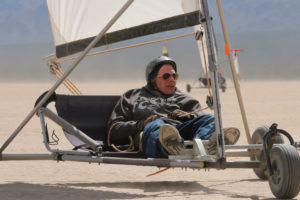
While Ivanpah is technically in California just over the Nevada border, it’s still largely considered a Nevada event because Primm is the gateway. Other Silver State terrain used primarily for land sailing includes Misfits Flat, just south of Stagecoach; Smith Creek Valley Dry Lake southwest of Austin via State Route 722; and Diamond Valley northeast of Eureka via S.R. 278.
On the NALSA website there are images from the 1998 “Holy Gale” event held in the Black Rock Desert. The Thrust SuperSonic car (jet-powered in this case) famously bolted across northwestern Nevada’s Black Rock Desert in 1997 at a world-record speed of 763.035 mph, or 2 percent above the speed of sound.
The annual Holy Gale has since moved to Smith Creek Valley, which is Nevada pilot Lester Robertson’s favorite event. Robertson is the owner of the aforementioned Misfits Flat land—where much of the famous 1961 film starring Marilyn Monroe was filmed—and the Carson City company Complete Millwork Service.
Robertson loves the competition of land sailing, but he also cites, “the silence of the desert; just setting down these contraptions, accelerating, and seconds later flying along at 50 mph in a cloud of dust,” he says. “The dust subsides, and you will find yourself five miles from camp without a breath of wind, hoping for the next puff to come in and take you home.”
Robertson, who heavily promotes youth land sailing, also speaks highly of the camaraderie that is such a big part of the sport’s makeup. “A lot of guys and gals have been friends for years—the same bond you find with the rock hunters, rocketeers…all of us waiting for the next year’s trips to the heart of Nevada, the Great Basin.”
Black Rock Goes Soft
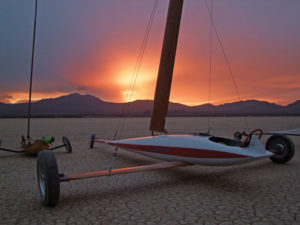
The Black Rock Desert in northwestern Nevada was once a premier land-sailing destination, but that’s not so anymore. The key, believe it or not, is moisture—or lack thereof. “It has not flooded since 2000 or thereabouts,” says Nevada pilot Lester Robertson. “Four years ago the surface went from so hard you did not leave imprints with your motorhome tires to so soft and crumbly a 250-pound dirt boat would sink so deep you cannot sail.”
According to Robertson, the Black Rock needs a substantial flood covering after which the water would soak deep into the subsurface. “Perhaps this will be the year we get the type of snow and rain we had when the Truckee River flooded and the Helms pit became Sparks Marina; that’s what it will take to repair the Black Rock Desert,” he says.

- City Limits

wsyc.org.uk
What Is Sand Yachting?
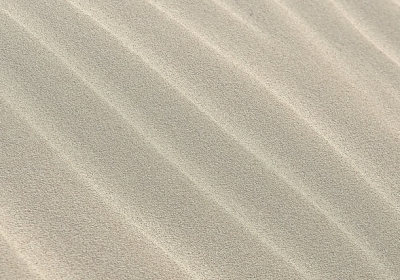
We all know what yachts are, and some of us have probably even been on one. Yachts usually belong in the water, but people have also come up with different ways of ‘sailing’ on land.
Sand yachting, which is also known as land sailing or dirtboating, is an activity characterised by the movement of a land vehicle which is powered by wind via a sail. While this activity may seem a bit wacky at first, there are plenty of enthusiasts who call themselves land sailers, and sand yachting has even become a sport.
So, how exactly does sand yachting work and why is it so popular in certain parts of the world? Let’s start from the beginning.
The History
The first sailing carriages were described in the 5th and 6th century China. This was the only place where they had kept existing until the arrival of European travellers that occurred some 500 years ago. In Europe, the first sand yacht was constructed at the beginning of the 17th century by the Flemish scientist Simon Stevin.
In the 19th century, the so-called ‘wind wagons’ were used in North America, while at the same time, the South Americans had their own version of sail cars.
The construction of modern sand yachts started in the 1960s, and one of the first official sand yachting races was organised in 1967 by the French in the Sahara.
Sand Yachting Competitions
Today, sand yachting is seen not only as a leisure activity, but also as a competitive racing sport. There’s even a recognised international association for the sport called FISLY. They are in charge of organising competitions and coming up with the general rules.
The most prestigious competition in this sport are the world championships that are held every couple of years. Each year, the tournaments get bigger and host more than 400 participants from all across the globe. Even some professional sailors, like the Olympic gold medalist Shirley Robertson, can be seen at these events.
How Fast Can Sand Yachts Go?
At first, you might think that sand yachts are not able to reach high speeds, but the fact is that these vehicles can reach over 150 km/h. The current world record holder is a British racer Richard Jankins who managed to reach the speed of 202.9 km/h back in 2009. He beat the previous record by almost 16 km/h and he did that at the Ivanpah Dry Lake in Nevada, USA.
Of course, the speed of the yacht depends on the speed of wind, but sand yachts can be more than three times faster than the wind propelling them. Even when the wind is blowing at a medium pace, well-designed sand yachts can go over 100 km/h.
The Most Popular Sand Yachting Locations
The best conditions for sand yachting are vast beaches and dry or frozen lakes. Therefore, this activity can be enjoyed in all parts of the world, especially in Western Europe, the UK, USA, Canada, Brazil, Argentina, Australia, New Zealand, and Africa.

Land Yachting – Sailing for Those who prefer land
September 30, 2019 Rob Sayers Experience Days , Extreme Outdoor Activities , Fun Outdoor Activities , Land Activities , Outdoor Sports , Physical Challenges 0

Blasting down the beach with your backside inches above the ground makes land yachting one of the most exhilarating sports I have tried. Powered purely by the wind in my sails, I joined a posse of stockbrokers who were intent on fulfilling their need for speed.
I tried land yachting as an outdoor activity gift from my wife through Red Letter Days . Activity gifts are one of the best ways to guarantee successful gift giving, at least for me.
What is Land Yachting?
The land yacht had three wheels for stability. In case you didn’t realise, it can be quite a challenge to get a four wheeled vehicle to have all four wheels evenly on the ground unless you put in some decent suspension. Land yachts don’t have suspension, and so you feel all of the bumps and bounces. Traction is provided through wind blowing in a large triangular sail attached to a mast mounted at the front of the land yacht. You sit in a very reclined position and hold onto a rope that pulls the sail in or releases it.
Do I need to be able to Sail to Control a Land Yacht?
Sailing a land yacht is far simpler than sailing a boat. There is no risk of waves, capsizing or falling overboard. Also, because you are lying down in the land yacht, there is no risk of being hit by the sail boom when you tack across the wind.
Your instructor will tell you the circuit for the day in relation to the wind and the technique for getting around corners to keep the wind. All you have to do is pull the sail rope and steer to avoid any of the other land yachts, dogs, people on the beach.
How to Control a Land Yacht
You steer a land yacht with two pedals, left and right. Some land yachts have hand levers for steering, but that only leaves one hand free for pulling the sail rope.
If you are facing the right way, all you need to do to get the land yacht moving is to pull the sail rope tight and keep it held tight. You musn’t loop the rope around your hands though, because if the rope pulls too much you could get rope burns or cuts. Land yacht racers usually wear gloves to protect their hands.
The tighter you pull the sail rope, the faster the land yacht will go, as long as you are not heading directly into the wind. As with any sailing sport, you have to work out which direction the wind is blowing to get the most speed. If you get it right, you find yourself hurtling down the beach with a rather huge grins on your face. Tight turns can lead to flying along on only two wheels, which is a bit hairy but awesome fun.
The Thrill of Land Yachting at High Speed
My Land Yachting Gift Experience
Whenever I get a gift experience I always open it with a sense of trepidation, wondering what experience I will be getting myself into. The Tiger Moth flight was a bit scary, mostly because people kept telling me that they had had dreams of me crashing and also because you didn’t get parachutes.
I was very excited when I opened the Red Letter Days envelope with a gift voucher for land yachting. It was something I had wanted to try for quite a while. I booked the two hour session on a beach near Rye in Kent and eagerly awaited that windy day.
It was easy to find, not least becuase of the big van plastered with signs for the land yachting company. The guys running the day were busy setting up the land yachts, which were left lying on their sides so that the wind didn’t blow them down the beach before time. There were quite a few rather nice cars parked at the side of the road, and talking to the other peope waiting most of them were stockbrokers. Land yachting must be one of those sports that attract people who have a need for that adrenalin rush. Engineering doesn’t necessarily give you such a buzz, but using some of the things you design certainly does.
We were given a brief training session on safety and how to control the land yacht. Then it was pretty much in you get and of you go. At first, it was a bit tricky getting around the first corner because you had to cross the head wind. If you didn’t turn quickly enough, you slowed down and stopped facing the wind. No amount of tugging on that sail rope would get you moving. the instructors stood on that corner to help get you moving again. After a few laps, I got the hang of it. At this point the instructors called me over to the centre to stop. I wondered what was up, and then they increased the height of the mast, which in turn unfurled more sail. This meant more speed! Awesome!
I was back out into the circuit and amazed by the increase of speed from increasing the sail size. One by one, the other bankers were pulled over to have a mast extension. Things then became quite competitive. Overtaking and racing ensued. I got such a thrill from overtaking others and a great sense of satisfaction if one of them lost the wind on a corner.
All in all, the two hours whizzed by and I was left wanting more.
How can I get to try Land Yachting?
You do need a licence to sail a land yacht on a public beach in the UK. The best way is to find a land yacht racing club.
If you want to buy your own land yacht, Blokarts are the most popular brand. The Potty is a UK land yacht design that will fit into the boot of your car.
If you want to try land yachting, you can buy land yachting gift vouchers from Red Letter Days. .
Recommended Reading
Privacy overview.
Advertisement
How Land Sailing Works
- Share Content on Facebook
- Share Content via Email
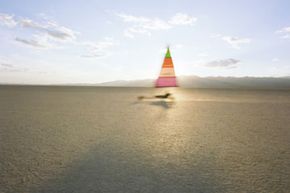
Imagine this: You're in your small sailboat, skimming along at speeds that top 50 or 60 miles per hour. The wind whips your face. Exhilarated, you skillfully guide your craft, moving the sail to adjust your speed. The landscape is a blur until you gradually head up into the wind and allow your sailboat to slow to a stop.
Then you step out of your boat, smiling, and walk over to the shade where your friends have been sitting, watching you sail.
No, you aren't walking on water. You're participating in an extreme sport called land sailing .
Some historians trace land sailing back to ancient Egypt and other cultures that used vehicles with sails for land transportation. Drawings exist of land sailors on the beaches of Belgium in the 1500s [source: Bassano ]. These days, land sailing is popular in Europe, where it's called sand sailing . Boats race along sandy beaches at low tide, and racers may attract big-name sponsors. Land sailing also is popular in New Zealand, Brazil and other places with wide, open spaces.
In the United States, land sailing gained popularity in the late 1960s and has been growing and evolving since. Racing dominates the sport, with events like the annual Americas Landsailing Cup regatta. In 2010, the event will take place March 21 through the 26 in Primm, Nev. But enthusiasts also enjoy recreational sailing.
Most racing happens on the dry lakes (playas) of high deserts. Land sailors also can be found on some beaches and even on sports fields and in parking lots.
The North American Landing Sailing Association (NALSA), an organization of individual land sailing groups, was formed in 1972. NALSA affiliated itself with the older International Land and Sandyachting Federation (FISLY) in Europe, which had developed rules and standards for its races [source: Embroden ].
Mark Harris, NALSA treasurer, said regular land sailors in the United States number in the hundreds, as compared to the thousands in Europe [source: Harris ]. But NALSA leaders expect more people to take up the sport, because it's relatively inexpensive, safe and environmentally friendly. Prices of popular models such as the Manta start at less than $2,000 [source: Wind ]. You don't need a dock, and the boat uses no fuel.
And best of all, land sailing is thrilling. Interested in trying your sea -- make that land -- legs? Read on to learn more about what makes land sailboats go.
The Physics of Land Sailing
Land sailing conditions, land sailing tips, land sailing safety.
Sailing on water and sailing on land have some things in common, but they also have a lot of differences. In fact, a land sailboat is really more comparable to a glider on wheels than a sailboat [source: Weber ].
Land sailboats usually have three wheels and one sail. They go too fast to use jibs or spinnakers. (Jibs and spinnakers are the two main types of headsails, or sails used in front of the mainsail, on sailboats.) Made by several manufacturers, land sailboats range in size from a sailboard (sort of like a surfboard with a sail) on wheels to a huge land yacht.
In smaller boats, the sailor may sit or lie on the frame. Usually, sailors steer with their feet, moving a T-bar , which basically is two pedals. You push with the right foot to turn left, and with the left foot to turn right. Steering with the feet leaves the hands free to use a rope (also called a line or sheet) to maneuver the sail. The sail is used primarily to adjust speed, not for steering. For some maneuvers, such as going around a racing maker, the land sailor will use the sail, but mostly just to adjust the speed to allow for accurate steering [source: Bassano ].
One brand, BloKart, uses a hand-operated tiller, so disabled people can sail.The tiller is a lever that helps steer; on a BloKart, it's attached to the wheels, while on a sailboat, it's attached to the rudder underwater that steers the boat [source: Blokart ]. In larger boats, the sailor may be enclosed except for the eyes and top of the head in a long, low craft. These sailors look like they've been stuffed, in a reclining position, into a close-fitting rocket ship or experimental aircraft with a sail. In racing, rules in some classes say that standard boats cannot be modified, while open classes regulate only the size of the sail and allow sailors to experiment with designs.
What attracts many people to land sailing is the speed. The speed record, set by Richard Jenkins in March 2009 at Ivanpah Dry Lake on the Nevada-California border, is 126.2 miles per hour (203.1 kilometers per hour). The wind that day was 40 miles per hour (64.4 kilometers per hour) [source: NALSA ].
The physics at work is the same as in water sailing, but the results are different because the conditions are different. Forces make things move, and forces can slow or stop moving objects. In sailing, the forces causing motion are the push of the wind on the sail and the pull of the air passing over the curve of the sail, creating lift much like on an airplane wing (but imagine it turned sideways). The forces holding back a water sailboat are the friction of the water on the hull and some friction of air on the boat and sails.
Land sailboats can go faster because their wheels face much less friction on dry surfaces. Because the whole boat is exposed to the air, land sailors meet more air friction, but that doesn't slow a boat nearly as much as water friction [source: Brinson ].
Land sailing isn't just sitting back and letting the wind push the boat, though. Sailors must move the boat side to side to maintain that lift.
What's it like to go land sailing? Read on.
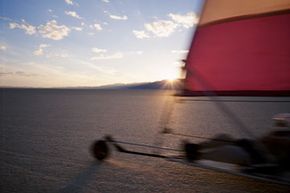
If you try serious land sailing, you're likely to be high as well as dry. The most popular places for land sailing in the United States are on dry lakes in the high deserts in California, Nevada and other Western states.
Dennis Bassano, North American Landing Sailing Association (NALSA) president, estimates that about half of land sailors started out as sailors on water. The rest of them are often people who ride motorcycles or all-terrain vehicles or people who try other sports on America's high deserts and happen to see land sailors while in the area. People see how fast land sailboats can go and want give it a try. There's also a lot of crossover with ice boaters, who in the summer switch out their runners for wheels and take up land sailing.
The primary season for land sailing is March through November. In between, rains make the dry lakes muddy bogs. The federal Bureau of Land Management allows land sailing on some public lands and even encourages it. Powered only by wind, land sailing has less impact on the environment than many sports do [source: Bureau of Land Management ].
Some popular land-sailing sites include:
- Black Rock Desert-High Rock Canyon Emigrant Trails National Conversation Area in northwestern Nevada
- Ivanpah Dry Lake, on the California-Nevada border, near Primm, Nev.
- The Alvord Desert in Oregon
- El Mirage Dry Lake near Victorville, Calif.
People who don't live near dry lakes sometimes sail on beaches at low tide, although most American beaches are too regulated or populated. Some people with smaller boats sail on athletic fields, in parking lots or on airstrips, when they can get permission. It takes more skill to sail in these smaller areas, where the boat is more likely to run into an obstruction.
On the dry lakes, the atmosphere is likely to be dusty, and the temperatures can be high. Sailors won't notice the heat once they get going, of course. Unlike in Europe, land sailing sites in the United States tend to be remote, without many amenities. Many people combine sailing with camping.
Read the next page for some tips on land sailing.
Take it easy, matey. If land sailing sounds interesting to you, don't just rush out and buy a dirtboat. Do a little research first:
- Rentals and charter trips are available, especially in the Western United Sates, for those who want to try before they buy. Such trips can be a fun vacation as well as a way to decide if you're serious about the sport.
- Attend local land sailing events to see what's involved. Many events are held spring through fall. The North American Land Sailing Association's Web site is a good place to learn about events and clubs in various locations.
- Talk to land sailing enthusiasts. Most are passionate about their sport. They love to talk and want the sport to grow.
- Investigate the various kinds of boats. They range widely in size and price. Land sailing is less expensive than water sailing.
- Attend the annual America's Landsailing Cup to get a good look at the different types of boats in action.
- Think about your goals: Do you just want to have fun, or might you want to get into racing? If you like to tinker, you might want to work with your own design in the open classes where the only restriction is the area of the sail [source: Harris ].
But with those high speeds, can land sailing be safe? Keep reading to find out.
Land sailing is a little like real estate: Location, location and location. People who live near or visit the high deserts in the American West with their dry lake beds find ideal conditions. But land sailing enthusiasts in less ideal locations sometimes have to be a little more creative, heading for airstrips, large parking lots, stadiums and other open expanses. One of the most unusual sites ever used for land sailing in the United States was the cornfields in Iowa owned by a farmer named Randy Harmon. Back in the early days of the sport in America -- the 1960s -- sailors would launch their boats in the fields after the crop had been cut. As Nord Embroden writes in his article about the history of land sailing in America posted on the NALSA Web site, the "corn stubble provided an adequate but bumpy surface" [source: Embroden ].
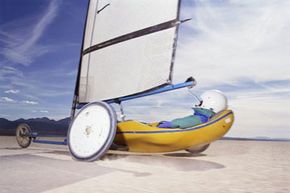
Land sailboats often go four to five times the speed of the wind. With a minimal wind of 10 miles per hour (16 kilometers per hour), you can be racing along at 40 to 50 miles per hour (64 to 80 kilometers per hour). When the wind speed is higher, boats may go two to three times the wind speed. Speeds of 80 miles per hour (128.7 kilometers per hour) are not unusual.
If you're flying along that fast in a boat with no real brakes, you could run into trouble. But land sailing is usually one of the safest of the extreme sports, if sailors use common sense. The first bit of common sense is using protective gear. Land-sailing tours and rentals insist on its use, and most land sailors use it as a matter of choice.
The main types of protective gear are:
- Helmets: a top priority.
- Seat belt: Those who go land sailing on beaches usually don't wear seat belts for fear of turning over into the water and becoming trapped. But in the United States, where they are sailing on dry lakes or other hard surface, most people do buckle up.
- Goggles or other eye wear
- Pads: Knee and elbow pads are usually good. The need for other pads may be determined by the type of boat and the position of the sailor -- what body part is likely to take a beating. Some people use shin pads; some use back protectors.
The larger the area for sailing, the safer. On a huge dry lake, there's little to run into. If you have trouble figuring out how to slow or stop the boat, you have room to figure it out. So, how do you stop the boat? Essentially, you stop it by steering it directly into the wind. Coming to a complete halt may take quite a distance. Sailors in smaller boats may drag their feet to help when the boat has almost stopped. Larger, enclosed boats have something like a parking brake to bring the craft to a stop once its speed is down to 4 or 5 miles per hour (6.4 or 8 kilometers per hour).
Those who sail in smaller settings take more risks. In parking lots, sailors can run afoul of light poles and curbs. Problems can arise in popular land sailing areas. If too many boats are sailing close together, some are likely to run into each other.
One of the obvious safety advantages of land sailing over its water cousin is that land sailors are unlikely to drown. If something goes wrong, a land sailor can get out of the boat and start walking.
Until your skills are well developed, it's a good idea not to sail too far from camp or vehicle. If you injure yourself, you don't want to have to trek a long way across a dry desert lake to your vehicle [source: Bassano ].
For more information on sailing and other sports, check out the links on the next page.
Lots More Information
Related articles.
- Extreme Sports Quiz
- How Skateboarding Works
- How Street Luge Works
- How Longboarding Works
- How Snowboarding Works
- How Luge Works
- How the X-Games Work
- How Daredevils Work
- How do you do a back flip in a wheelchair?
- About Go Landsailing. (Dec. 15, 2009)http://www.golandsailing.com/?gclid=CKHjmMHr7J4CFUKZ2AodegryJw Go Land Sailing.com
- "Alvord Desert." U.S. Bureau of Land Management. http://www.blm.gov/or/resources/recreation/site_info.php?siteid=5
- "An Introduction to Land Sailing." Sailing Ahead. (Dec. 21, 2009) http://www.sailingahead.com/information/land-sailing.htm
- Bassano, Dennis. President, North American Land Sailing Association. Personal interview via telephone. (Dec. 19, 2009)
- "BloKart: Best Toys on the Planet." BloKart. (Dec. 21, 2009)http://www.blokart.com/about.php
- "Book a Trip -- Get Blown Away!" Land Sailing Tours LLC. (Dec. 22, 2009) http://www.golandsailing.com/reserve_california.htm
- Brinson, Lloyd. M. Ed. in Physics, UNC Greensboro. High school physics teacher, retired. Personal interview. Dec. 22, 2009.
- "Description of Land Sailing." Wind Chaser. (Dec. 21, 2009)http://www.wind-chaser.com/about/about-landsailing/landsailing-description.html
- Embroden, Nord. "Landsailing in America." American Landsailing Federation Newsletter May 12, 1998. Reprinted on http://www.nalsa.org. (Dec. 15, 2009)http://www.nalsa.org/landsailing_in_america.htm
- Harris, Mark. Treasurer, North American Land Sailing Association. Personal interview via e-mail, Dec. 19-20, 2009.
- "Introduction to Land Sailing." Landsailing.Net. (Dec. 15, 2009)http://www.landsail.net/introduction_to_land_sailing.htm
- "Ivanpah Dry Lake." U.S. Bureau of Land Management.http://www.blm.gov/ca/st/en/fo/needles/ivanpah.print.html
- "Manta landsailers." Windpower sports.com. (Dec. 23, 2009)http://www.windpowersports.com/landsailers/
- North American Land Sailing Association. (Dec. 15, 19, 21, 22, 2009)http://www.nalsa.org
- "Off-Highway Vehicle Areas & Trails." U.S. Bureau of Land Management. http://www.blm.gov/nv/st/en/fo/wfo/blm_programs/recreation/off-highway_vehicle.html
- "The Sirocco, Sirocco Spring, and Sirocco Twin -- Great Fun, Outstanding Performance." Sirocco Land Sailer. (Dec. 21, 2009)http://www.windline.net/sirocco.htm
- Weber, Robert. Southern vice president, North American Land Sailing Association. Personal interview via telephone, Dec. 19, 2009.
- Weber, Robert. "Water Sailing vs. Hard Surface Sailing."http://www.modellandyachts.com
Please copy/paste the following text to properly cite this HowStuffWorks.com article:

- Outdoor Activities
- Destinations
- Book Hotels, Flights & Cars
- Advertise With Us
- Cookie Settings
Copyright © 2024 MapQuest Holdings LLC, a System1 Company

Hidden Belgium: Sand Yachting at De Panne
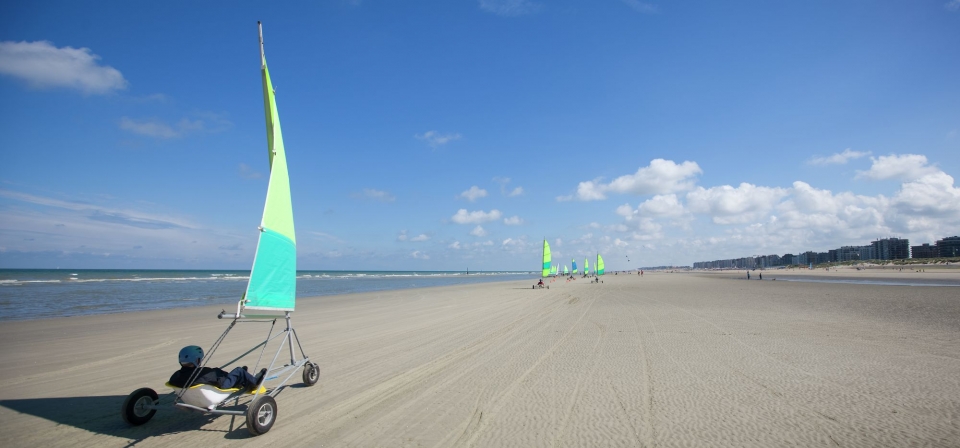
When the wind is right, you can ride a sand yacht along a 30-kilometre stretch of wide sandy beach between De Panne and Dunkirk.
The sport was brought to the Belgian coast in 1898 by André Dumont and his seven brothers. André launched the idea by attaching a sail to a wooden go-kart. The sport caught on. In 1927, François Dumont established the Sand Yacht Club (the name in English to add a touch of snob appeal).
The sleek land yachts can reach speeds of over 125km/h on one of the best beaches in the world for the sport.
You can sign up online ( rsyc.be ) for a private lesson run by the Royal Sand Yacht School. Or get together with some friends for a group session out on the sands.
Derek Blyth’s hidden secret of the day: Derek Blyth is the author of the bestselling “The 500 Hidden Secrets of Belgium”. He picks out one of his favourite hidden secrets for The Brussels Times every day.
Copyright © 2024 The Brussels Times. All Rights Reserved.
Vogue Travel
Get Travel Ideas and Inspiration with Vogue Travel
Search This Blog
9 places to go sand yachting in normandy, during your next vacation, practice sand yachting in normandy here are 9 beaches for sand yachting in normandy.
With sandy beaches as far as the eye can see, Normandy is the ideal region for sand yachting. The so-called “ship of the sands” was already used several millennia ago by the Egyptians! It was Europeans who made it a hobby more than a century ago. Between the wheeled car and the small sailboat, sand yachting in Normandy is an activity that quickly offers feelings of freedom and fun. At ground level, you use the force and direction of the wind to gain speed and move. This very accessible water sport does not require any particular physical condition.
1. Landing Beaches

Crédit Photo : Shutterstock – photoneye
Sword Beach, Juno Beach, Gold Beach, Omaha Beach, Utah Beach ... Welcome to the Landing beaches, rich in history and emotion! Here, you can combine the practice of sand yachting and visiting the museums dedicated to this military operation of the Second World War .
Also Read: 18 Most Beautiful Beaches in Normandy
Located on a protected natural site, the kilometers of Omaha Beach and Utah Beach are ideal for nautical leisure. Arromanches-les-Bains is also one of the unmissable beaches for sand yachting in Normandy. Nicknamed Gold Beach, it still bears the traces of the large artificial port which welcomed the Allied troops during the liberation of 1944. Providers offer sessions of two to three hours throughout the year.
2. Saint-Aubin-sur-Mer

Credit photo: Shutterstock - Christian Musat
Located very close to Dieppe on the Côte d'Albâtre, the sandy beach of Saint-Aubin-sur-Mer provides easy access to sand yachting, especially when coming from the Paris region. Dieppe is indeed just over two hours from Paris . Saint-Aubin-sur-Mer is the most imposing beach in Seine-Maritime.
Just after the tide, the sea recedes, gradually creating a huge race track. All year round, depending on the tide times, two-hour sessions are offered by local clubs.
3. Consider the Sciotot
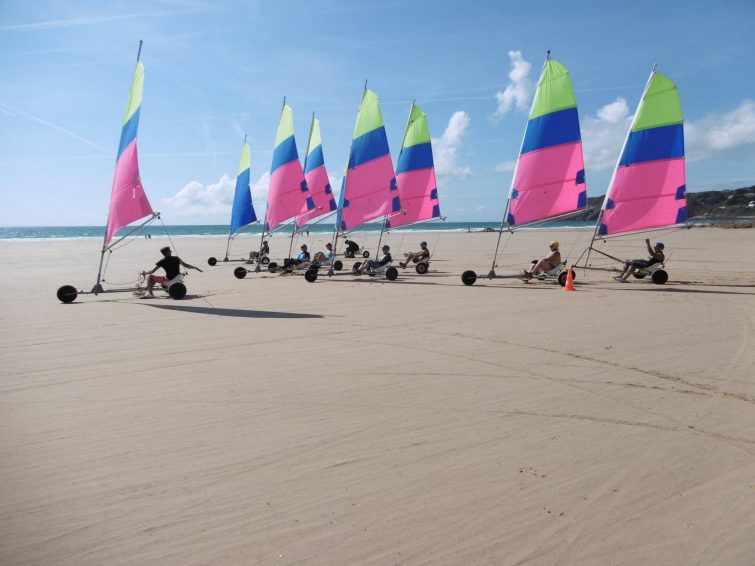
Photo Credit: Facebook - Sciotot Sailing and Wind Activity Center
Among the Cotentin beaches, that of Sciotot is a perfect spot for sand yachting in Normandy. Between the Flamanville and Rozel capes, it is part of the commune of Les Pieux in the Manche. Its stretch of sand is four kilometers long. Its wild aspect and its size make it an excellent playground for all, from the age of 8 years.
Did you know that in 2019, the newspaper Le Monde ranked Sciotot fifth most beautiful beach in Europe ? All the more reason to consider a nautical leisure stay!
4. Trouville-sur-Mer
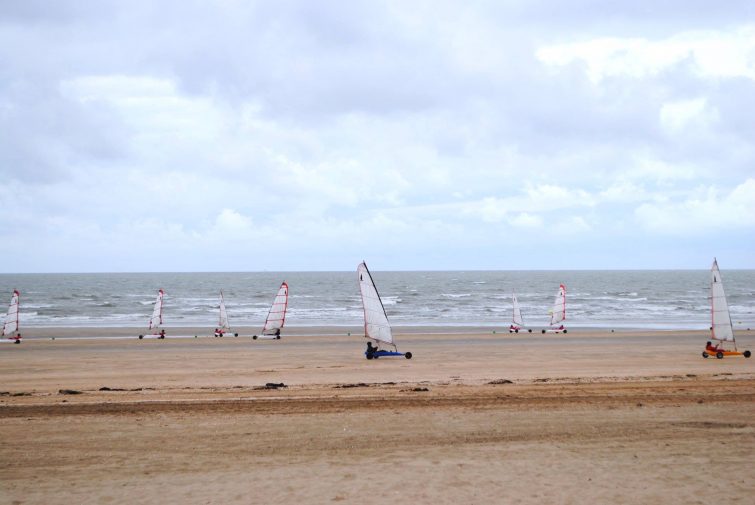
Photo credit: Facebook - Trouville sur Mer Tourist Office
To practice sand yachting in Normandy in a mythical place, you have to come to Trouville-sur-Mer. Located very close to Deauville, this seaside resort is the oldest in the region. Its large sandy beach stretches for 1.2 kilometers. It combines nautical leisure, relaxation and history.
In Trouville, you can not only try sand yachting, but also discover Beach Karts! These small remote-controlled vessels take up the codes of land yachting, on various routes. Finally, children's clubs and facilities allow the whole family to have fun at the same time.
5. Jullouville
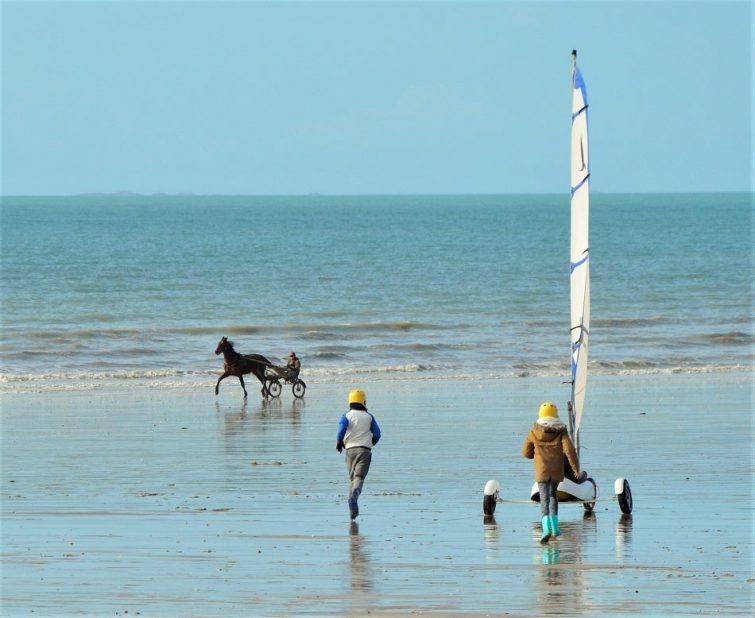
Photo credit: Facebook - Jullouville town hall
Located 8 kilometers from Granville, the large Jullouville beach stretches from Saint-Pair-sur-Mer to Carolles for approximately 2 kilometers. Accessible by stroller, it is above all a family beach. Its numerous animations in season also help to delight young and old alike.
At low tide, it becomes the nerve center of shore fishing and sand yachting. The sailing base of Jullouville is also THE spot in the south of the Channel for this activity. Notice to thrill seekers: the beach is open to the bay, which gives it exposure to winds conducive to speed gain!
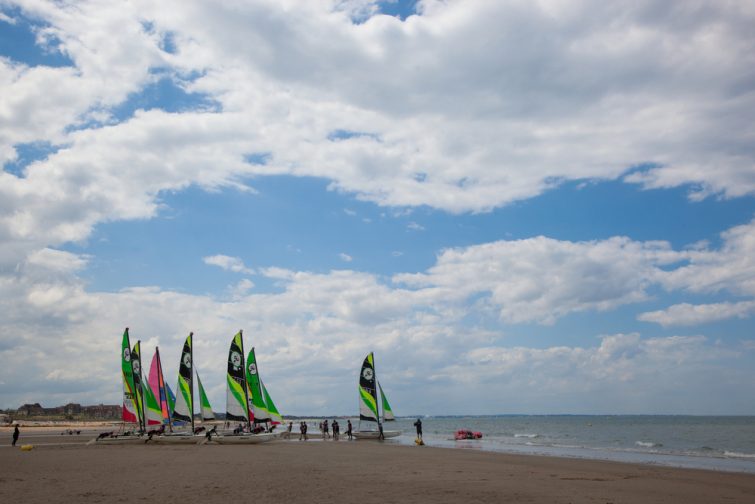
Crédit photo : Shutterstock – flydragon
Between Caen and Deauville, the "romantic beach" stretches over almost 4 kilometers of fine sand. Visiting Cabourg will give you the opportunity to practice sand yachting in Normandy, in a unique setting. The Grand Hôtel Belle Époque , the casino and the Marcel Proust promenade are all attractions that can be observed from the beach.
The seaside resort also has the Family Plus Label: clubs specially dedicated to children are installed on the beach. If you come with your family, you can let your children have fun during your initiation to your new favorite hobby! What a pleasure also to reward his sporting efforts by eating an ice cream at the end of the afternoon on the longest pedestrian promenade in Europe.
7. Ouistreham
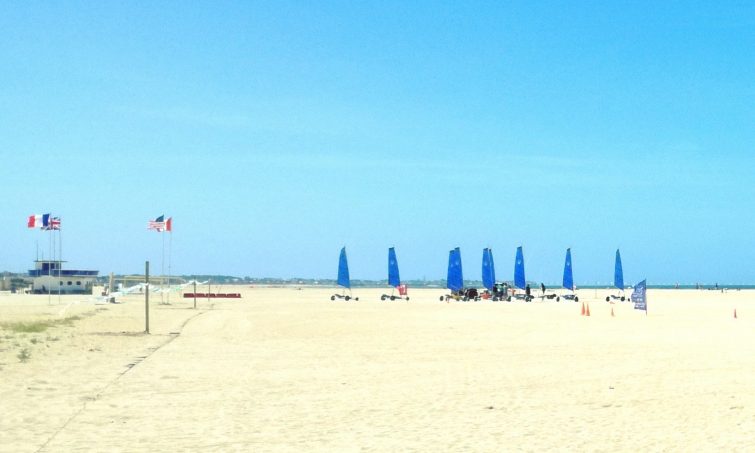
Photo credit: Facebook - Sweet Home Cabourg
Head for Ouistreham Riva-Bella beach! Labeled a 3-star Nautical Station, the Pearl of the Côte de Nacre is perfect for lovers of marine sports. Among the range of possible activities, sand yachting is a must.
Before setting off on the sand, take the time to observe the changing landscapes, capped by the dunes that separate you from the city…

8. Bretteville-Sur-Ay

Photo credit: Facebook - Ay-ole sand yachting center
Are you looking for a huge, wild and untouched place for tourism? Welcome to Bretteville Beach! Ten kilometers of beach between the two harbors of Saint-Germain-sur-Ay and Surville, a view of the island of Jersey : yachting aficionados will be delighted! The small town of Bretteville-sur-Ay is located on the D650, which locals also call the "tourist route".
From Cherbourg to Coutances, it runs along the Normandy coast and smells of holidays, the sun and the hot sand (in summer!). Taking this legendary route will take you to several sites of tourist interest ... and many sand yachting spots. Are you ready for the Normandy sand yachting tour?
9. The Bay of Mont-Saint-Michel

Crédit Photo : Shutterstock – 365_visuals
To practice sand yachting in Normandy in a mythical place, nothing better than the bay of Mont Saint-Michel. Very close to Mont Saint-Michel, on Hirel's shore, you will be introduced to the pleasures of sand yachting.
The session takes place in two stages: you will approach the sand yachting from a theoretical point of view during a briefing, then once the safety rules are understood, you can let yourself slip into this boat. Notice to thrill seekers!
Practical information for sand yachting in Normandy
The activity.
Sand yachting is a hobby where you seek both to gain speed and to steer your craft, propelled by the force of the wind. You quickly manage to control your little ship and gain a very pleasant feeling of freedom. The tank can be single or two-seater . The tandem version is particularly suitable for taking a child on their lap or for feeling reassured by the presence of an instructor.
The conditions of practice
The sand yachting is accessible to everyone , from 7 to 77 years old. It is best done at low tide, when the beach is huge and you draw lines on the still wet sand. A minimum force 3 wind is required to propel and steer. The ideal is also to ride on a very compact sandbank.
The equipment
For a successful session, bring warm clothes (sweater, fleece), an old pair of closed shoes, sunglasses and gloves. Generally, clubs provide helmets and waterproof clothing (coveralls, waxed). Also think about your change of clothes!
So what are you waiting for to make sand yachting in Normandy?
A sand yacht to harness the wind
- I'm looking for
Le Touquet-Paris-Plage
Home Le Touquet-Paris-Plage Sports heaven A sand yacht to harness the wind
Scroll down
Bertrand Lambert has left a legacy to be proud of. The five-times world sand-yachting champion has made this discipline an iconic sport of Le Touquet-Paris-Plage! No wonder the Manche Watersports Centre has been named after him.
Because the Opal Coast’s southern beaches are ideal for sand-yachting, Le Touquet regularly hosts national and international competitions. In 2006, for example, the world championship took place here, offering a rare spectacle far too good to miss under any circumstances!

A competition setting
Top athletes can perfect their skills in this optimal environment. So the competitions offer the perfect opportunity to admire their performance. Like in April 1991, for example, when Bertrand Lambert smashed the world speed record by reaching 151.55km/hour! Both world champions, his daughters Charlotte and Clémence have followed in his footsteps. What about you? Fancy trying for the next champion title? Click here for further information about the Bertrand Lambert Manche Watersports Centre
Sand-yachting, try it once and you’ll be hooked
At low tide, vast stretches of the beautiful 7km beach of fine sand are exposed, offering the ideal terrain for hitting those top speeds aboard one of Le Touquet’s elegant sand-yachts. All it takes is a favourable wind to see the white sails bearing the famous caddie, hurtle at full speed across the sand.

With the wind in your hair, you can try your hand at the helm of this sand vehicle gliding along with the wind as its only power source. The watersports centre proposes sand-yachting lessons and courses, and even one-to-one tuition for beginners from the age of 8 years. You’ll quickly learn to handle the vehicle and start enjoying the thrill from the very first session in complete safety. Just what you need to build confidence and, basically, get yourself hooked on this new experience.

Seizing the moment

48th Enduropale races of Le Touquet-Pas-de-Calais
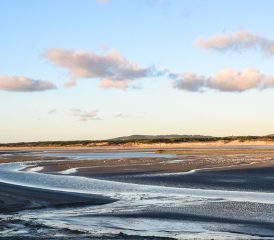
Seashore magic
Also…
Find inspiration
Top of the page
- 0 Favorites
Sand Yachting
Normandy Tourism, France
- Active & outdoor
- Lifestyle & Wellness
- Discover Normandy
- Plan your trip
Updated on 23 June 2020
Sand yachting on the long sandy beaches in Normandy makes for fun memories!
For a fun photo option, check out our selection of spots: in the Manche , in the seaside resorts of Cabourg, Deauville , Trouville-sur-Mer , on the D-Day Landing Beaches
More filters
Display map
Result(s) 1 at 12 on 17
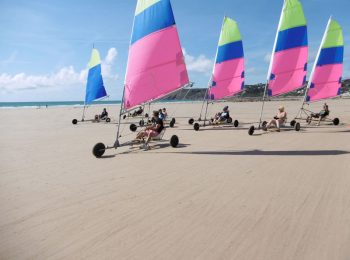
Centre d’Activités Voile et Vent
Add to bookmark
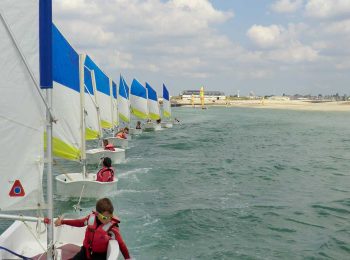
PORT-BAIL-SUR-MER
Ecole du Vent en Côte des Isles – U.S.P Sports Nautiques > Base La Caillourie

Ocean Watersports – Land Yachting School

HERMANVILLE-SUR-MER
Hermanville Sailing and Leisure Club (CVLH)
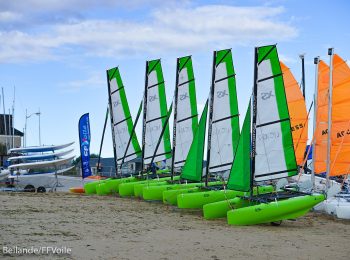
LUC-SUR-MER
Luc Yacht Club : école de voile

BRETTEVILLE-SUR-AY
Ay-Ole Centre de Char à Voile

Centre Nautique Est Cotentin > Quinéville
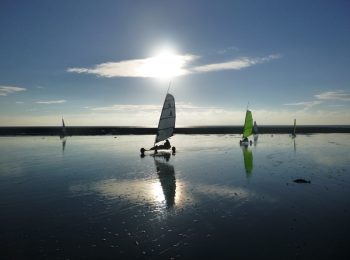
Ecole du Vent en Côte des Isles – U.S.P. Sports Nautiques > Base de char à voile Rue Rozé
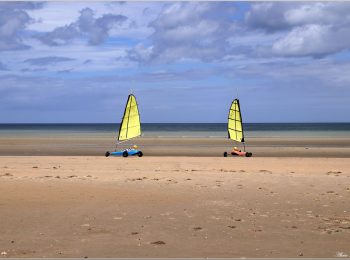
SAINTE-MARIE-DU-MONT
Utah Mer Loisirs
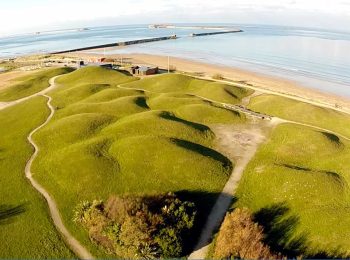
CHERBOURG-EN-COTENTIN
ÉCOLE VOILE ET VENT TOURLAVILLE
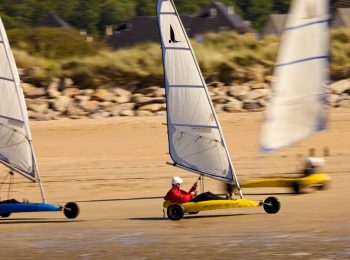
Cabourg Land Yachting School
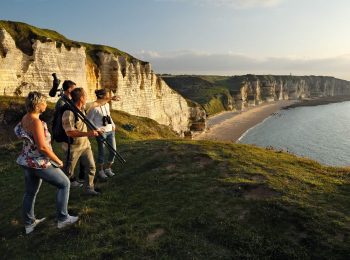
Asnelles Gold Beach Watersports & Leisure Centre (CLNA)
17 résultat(s)
Return to top
Are you already in Normandy?
Plan what to see and do while you’re here by visiting normandy-secrets.com, which lets you in on all of the local secrets and hidden gems in the immediate vicinity!
Close search box

Plan Your Visit
- Experiences
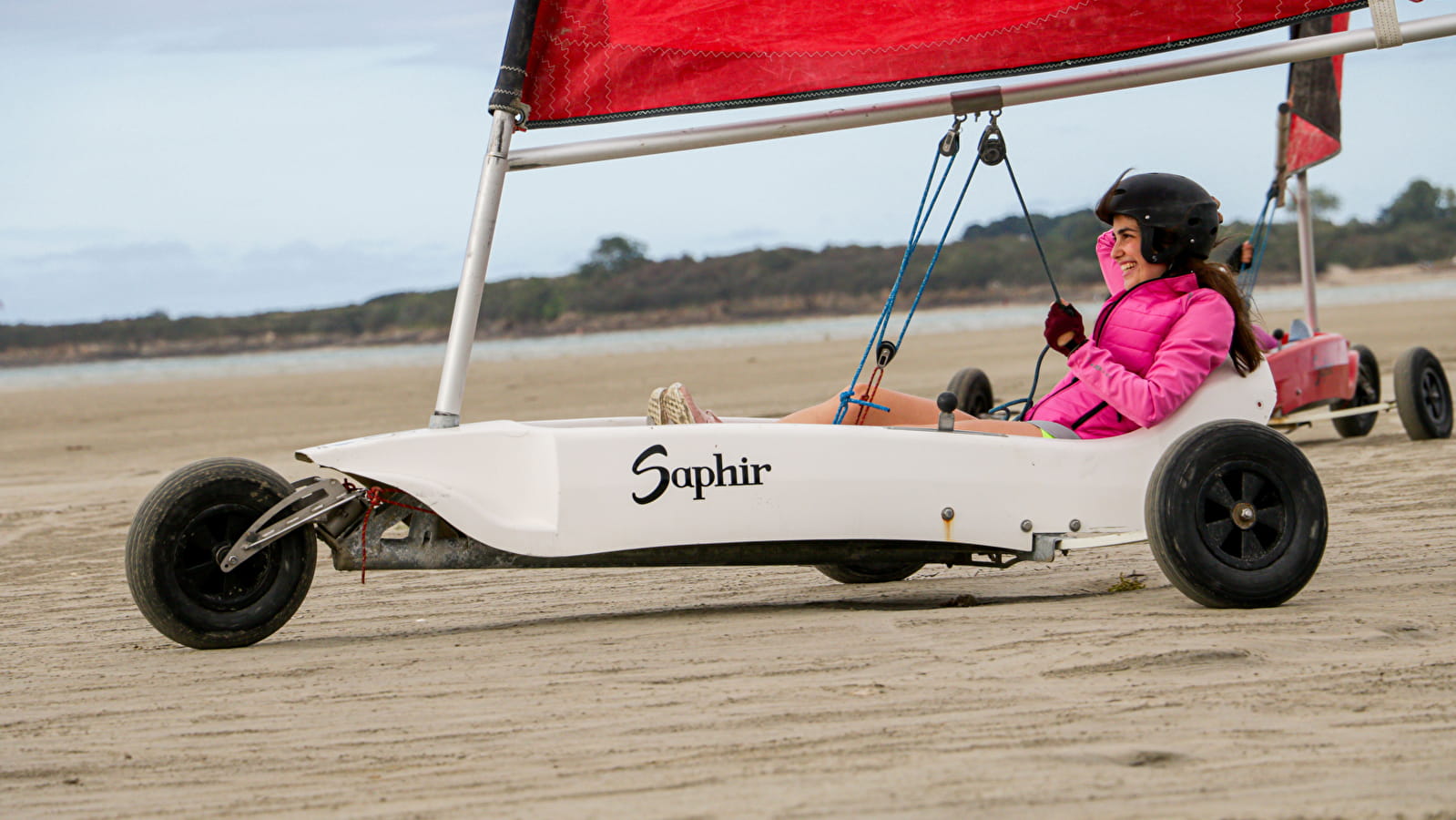
sand yachting in Brittany
- Test sand yachting in Brittany
In the landscapes of our beautiful Brittany , there's nothing like an outing to the open sea to oxygenate the mind... And if we added a pinch of thrills? Let's swap our swimsuit for a completely different outfit: we're off for a morning of sand yachting initiation!
How to do sand yachting?
To practice this sliding sport, nothing could be simpler: all you need is a little wind (which comes from the sea), a low tide and a great desire for adrenaline!
Direction the sailing school where the instructor welcomes us to explain how the machine works. The technique to start? Imagine that we have a bicycle handlebar... To handle with the feet! To move forward and master the speed, he explains the vocabulary words to remember: “trim the sail” means pulling on the sail; “shock the sail” means to release the sail. How to stop? We asked him and here is his answer: the sand yacht has no brakes! The instructor reassures us and shows us that the sand yacht stops as soon as we face the wind! We put on our helmets, it's up to us!
- Check if the wind comes from the open sea: it will not be cut off by the monuments and will remain stable
- Handles like a bicycle: the feet direct the direction, the arms regulate the speed
- To slow down: lower the sail
- To speed up: tuck in the sail
- To stop: face the wind
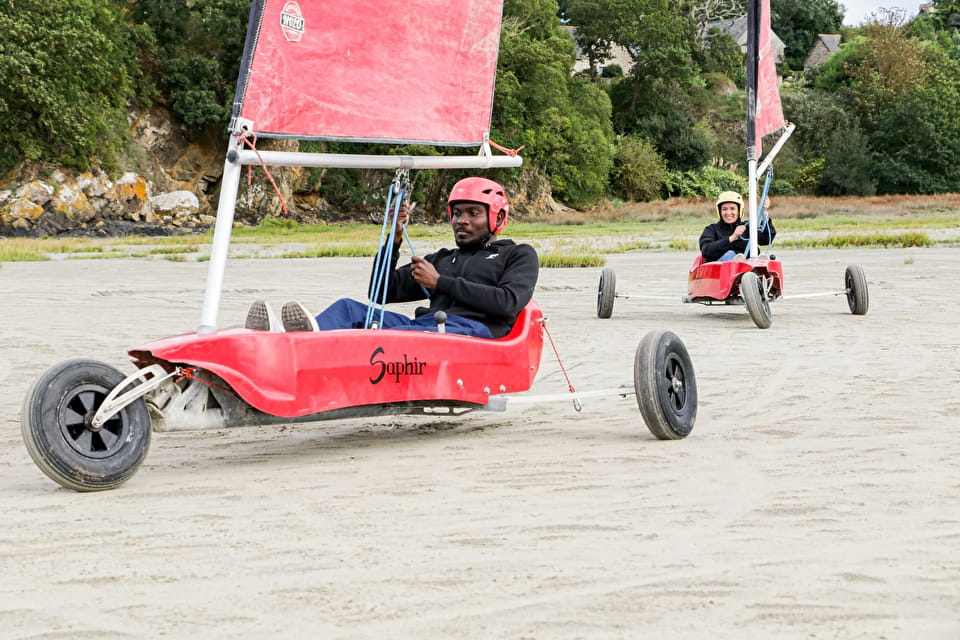
Discover the sensations of sand yachting
Sitting at ground level, each on his own machine, we begin our first sand yachting session in Brittany! We remember the instructor's precious instructions and let our racing car glide along the Brittany coast. The least we can say is that the sensations are not long in coming! The sand yacht accelerates slowly (with a few jerks, lack of control on the first try of course), but after only a few minutes, the speed begins to stabilize little by little.
If we had to describe our sensations? Certainly the same as those we can find in karting, but with the sound of the waves replacing that of the engine: a real pleasure!
- Sand yachting is a great water activity if you're looking for adrenaline
- The average speed of the sand yacht is 60km/h. The more seasoned can drive up to 100km/h!

Test sand yachting in Brittany: for whom?
In Brittany as elsewhere, the practice of sand yachting is accessible from an early age! In general, the first sessions can be given from 6-7 years old, when children are able to dissociate the movements of the arms and legs.
For the great beginners, we try to favor the days when there is little wind, in order to start gently. Great fans of speed, tricks and skids will have a great time on days with strong winds!
- Sand yachting is recommended from around 6-7 years old (ask sailing schools)
- It is possible to do initiation sessions for children and adults: a great opportunity to go out to the water's edge with the family!
- For complete beginners, it is recommended to test the sand yacht on a “light wind” day.
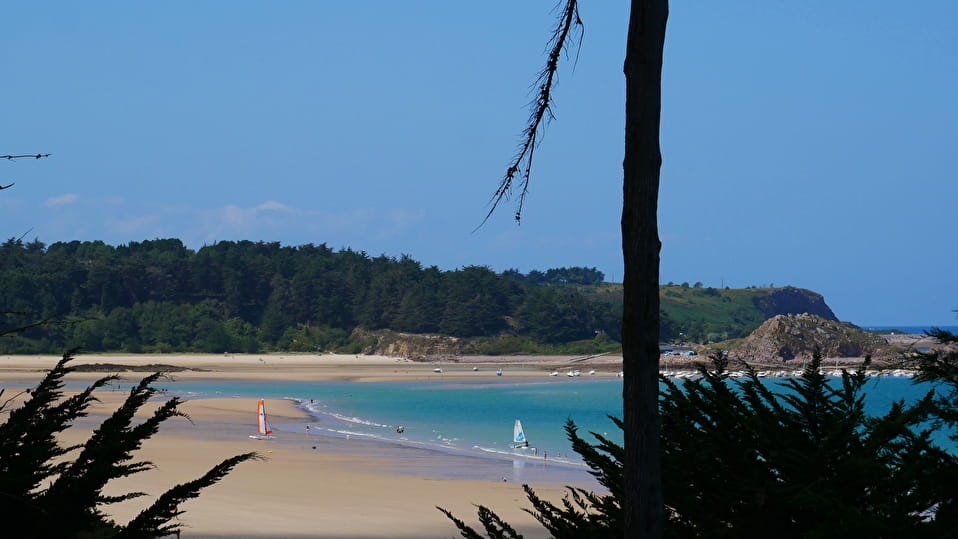
Where to test sand yachting in Brittany?
To test sand yachting in Brittany, here are our 3 spots to remember in Dinan-Cap Fréhel:

From Rougeraie beach to Beaussais Bay, the place is ideal for all levels. In addition, the sailing school is open all year round!
Sailing school in Saint-Jacut-de-la-mer

In Sables-d’Or-les-Pins , the dune landscapes welcome you for a beautiful ride in a sand yacht, on one of the most beautiful beaches in Brittany! In the program ? 3 km of fine sand, pine trees, the bay of Saint-Brieuc... A magical place to test sand yachting in Brittany!
Nautical Center of Fréhel in Sables-d'Or-les-Pins

The Bay of Mont Saint-Michel is a good place to learn sand yachting! Brittany's 7 km long stretch of coastline guarantees great acceleration… Meet at the sailing school, labeled “French sand yachting school”!
Sailing school in the Bay of Mont-Saint-Michel
You may also like...

- Our must-haves
- In the heart of nature
- Ideas for getaways
- Take advantage of the off-season
- Our destination has talent
- Best things to do
- Walks and hikes
- Holidays for all
- Consume local
- Shops and services
- Tickets on sale at the Tourist Office
- Come and move to the destination
- Our brochures
- Our Tourist Offices
- Tourist office shops
- When is the next high tide?
Enter one or more keywords to start a search

Capricornia Blokart Club, Yeppoon, Queensland
Yeppoon’s beaches were made for Sand Yachting! Everyone can enjoy land sailing.

2024 Capricornia Blokart Bash
The 2024 Capricornia Blokart Bash will be at Mulambin Beach, Yeppoon Queensland from Friday 31st May to Monday 3rd June 2024.
Download the Notice of Race and important information regarding the event.
Check out the poster.
Entry Form.
The registrations, social events will be held at the NRMA Capricorn Yeppoon Holiday Park.
We recommend that you stay at the NRMA Capricorn Yeppoon Holiday Park.
Call them on 1800 068 703 or Click on this link to go to their website.
Tell them you are with the Blokart group.

We thank NRMA, Keppel Bay Sailing Club, Livingstone Shire Council, Blokart International, Australian Blokart Association and Oldfart Blokarts for their support.
Links & Info
Subscribe to our periodic Newsletter. We will never pass on your information to any 3'rd party and you can unsubscribe at any time with the click of a button.
Thank you for subscribing to our Newsletter.
0481 058 088
Please click here

© 2024 Sand Yachting. All rights reserved.
Created by STERNDALE
'Access to hidden-gem ports': Why this luxury yacht is the best option for beach lovers
“This is your yacht, to do with as you please,” Captain Rob O’Leary said to guests of the Emerald Sakara , the second luxury superyacht from Emerald Cruises. “We have an international crew from 21 different nations, and we are all here for you.”
I was on the maiden voyage of the 360-foot Sakara, a December 2023 sailing with the added glamor of a Champagne christening in San Juan, Puerto Rico, led by the ship’s godmother Kelly Craighead. She is president of Cruise Lines International Association, the industry’s leading trade organization.
“Sakara” is a Sanskrit word meaning “thoughts become things” – a fitting name, given the thought that went into the ship’s chic design. And our itinerary for the week couldn’t be more yacht-like – an island-hopping experience in the West Indies, stopping in out-of-the-way ports that larger cruise ships can’t manage. And while some smaller boats can feel rocky, the Sakara’s stabilizers keep the ship on an even keel.
Are luxury cruise ships worth the money? We did the math for Silversea's Silver Nova.
With just 100 guests and 76 crew, the Sakara is part of the larger trend in cruising: smaller ships that cater to vacationers who want the style and feel of a yacht, and the intimate service that accompanies that, with the amenities of a larger ship. Craighead said that small-ship cruises offer “luxury at a great value, access to hidden-gem ports and unique features like marinas for water activities directly off the ship,” she says. “These small ships can even be chartered, for your own amazing, private yacht experience.”
After departing from San Juan, the Sakara reached the Puerto Rican island of Culebra in a few hours, just 20 miles off the coast. We hopped in a taxi van at the port to reach the pristine waters of Flamenco Beach, which consistently makes the world’s top 10 lists. It was a fall-asleep-on-the-sand kind of day, under brightly colored umbrellas, with multiple trips to the canteen for French fries.
“I hope you enjoyed Culebra today because it’s quite hard to get in, through a very narrow channel,” O’Leary said at a supper-hour briefing.
The next day, we stopped at the nearby island of Vieques, which is filled with wild horses – about 2,000 of them – most of whom are fully accustomed to the photo op. We docked at Esperanza Bay and wandered the waterfront. There were jeeps or ATVs available to rent for those who wanted to beach-hop, but we settled into the sand at Sun Bay. And when we sailed into Cruz Bay on the U.S. Virgin Island of St. John the following day, there were yachts and catamarans everywhere – and the Sakara fit right in.
The crew outdid itself the next day at White Bay Beach on Jost Van Dyke, the smallest of the British Virgin Islands. A barbecue feast awaited us, along with beach loungers, steel-drum entertainment, and all the paddles and water toys from the ship. Later, we wandered down the beach to find a young yacht crowd, groups of friends who have rented their boats, all knee-deep in their mojitos.
“I get a real kick out of driving the Emerald Sakara into St. Barths, muscling in and anchoring next to all the other superyachts,” O’Leary said. “It looks good in the pictures.” A stop there brought a snorkeling excursion, a bit of high-end shopping and a few rosé-soaked hours on Plage de Saline.
Back on board, the creature comforts of the Sakara included plenty of outdoor space to connect with the ocean, a small infinity pool, a full-service spa and a large, elegant dining room and terrace. It’s all part of the cushy yacht lifestyle.
The ship will spend the summer and fall cruising the Mediterranean Sea – heading for the French and Italian rivieras, Croatia and Greece – with eight-day itineraries from $5,100. The Emerald Sakara will be back in the Caribbean next December, with eight-day cruises starting at $4,100.
Editor’s note: The contributor of this story received access to this cruise from Emerald Cruises. USA TODAY maintains editorial control of reviews.

IMAGES
COMMENTS
Land sailing, also known as sand yachting, land yachting or dirtboating, [1] entails overland travel with a sail -powered vehicle, similar to sailing on water. [2] Originally, a form of transportation or recreation, it has evolved primarily into a racing sport since the 1950s. Vehicles used in sailing are known as sail wagons, sand yachts, or ...
The first French sand yachting clubs sprung up on the beaches of northern France in the 1950s. Today - Since then the sport has grown in popularity and spread across the globe from its home in the stretches of Northern Europe's beaches. Popular due to its accessibility for beginners, and most ages (depending on the strength of the wind in ...
Learn about the sport of land sailing, a fusion of sailboats, iceboating, and fast automobiles. Find out where and how to do it, the history and types of racing, and the challenges and rewards of this thrilling and unusual activity.
The Manta can be set up for landsailing action in 5 minutes. The ultra-lightness is revolutionary because it permits exciting operation even in small areas. The WinJammer weighs just 70 lbs, with a fully battened sail of 45 sq/ft and a turning radius under 6 feet. The TwinJammer weighs 105 lbs, carries 59 sq/ft of sail and has a turning radius ...
Land yachting, also known as sand yachting or land sailing, is the ideal combination of sailing and motor racing, using the power of the wind to accelerate t...
With winds gusting up to 50 miles per hour, Ivanpah Dry Lake is a regular destination for adrenaline junkies participating in land sailing competitions on narrow three-wheeled wind-powered buggies.
Land sailing, also known as sand yachting or land yachting—or as Harris likes to call it, "dirt boating"—has evolved primarily into a racing sport in the last half century. Its roots can be traced as far back as 6th-century China. Centuries later, some European royalty used land yachts for entertainment, and they were even used hundreds ...
Sand yachting, which is also known as land sailing or dirtboating, is an activity characterised by the movement of a land vehicle which is powered by wind via a sail. While this activity may seem a bit wacky at first, there are plenty of enthusiasts who call themselves land sailers, and sand yachting has even become a sport. ...
Welcome to the homepages of. FISLY. the International Land and Sandyachting Federation. FISLY YOUTH CAMP (12 - 14 August 2024 - Marck France) Access to the "FISLY INTERNATIONAL PILOT REGISTRATION".
Land yachting is sometimes called land sailing or sand yachting, but can be done on any large area of flat open land. Beaches, dry lake beds and private airports are the favourite locations because they are flat and open to the wind. The land yacht had three wheels for stability. In case you didn't realise, it can be quite a challenge to get ...
Some historians trace land sailing back to ancient Egypt and other cultures that used vehicles with sails for land transportation. Drawings exist of land sailors on the beaches of Belgium in the 1500s [source: Bassano]. These days, land sailing is popular in Europe, where it's called sand sailing. Boats race along sandy beaches at low tide, and ...
Land sailing is an amazing fun sport that basically involves racing on a wheeled yacht that is powered by wind. Land sailing also known as "sand yachting", "land yachting" or "dirt boarding". Land sailing or "wind-driven carriage" has been around as a way of transportation and recreation since the 6th century BC, but it became a sport during ...
Hidden Belgium: Sand Yachting at De Panne. When the wind is right, you can ride a sand yacht along a 30-kilometre stretch of wide sandy beach between De Panne and Dunkirk. The sport was brought to the Belgian coast in 1898 by André Dumont and his seven brothers. André launched the idea by attaching a sail to a wooden go-kart. The sport caught on.
The World Landsailing Organisation or Fédération Internationale de Sand et Landyachting (FISLY), is an international organisation which governs national associations of land sailing worldwide.. The federation was founded in April 1962 by representatives from Belgium, Germany, the Netherlands, France, and Great Britain.. In October 2018, FISLY became an observer member of the Global ...
4. Trouville-sur-Mer. To practice sand yachting in Normandy in a mythical place, you have to come to Trouville-sur-Mer. Located very close to Deauville, this seaside resort is the oldest in the region. Its large sandy beach stretches for 1.2 kilometers. It combines nautical leisure, relaxation and history.
Welcome to the exciting world of sand yachting on France's northern beaches. An adrenaline-fueled adventure that combines the beauty of the coastline with the thrill of high-speed racing, sand yachting is a unique experience that will leave you breathless. Whether you're a seasoned sailor or a first-time adventurer, the northern beaches of ...
Sand-yachting, try it once and you'll be hooked. At low tide, vast stretches of the beautiful 7km beach of fine sand are exposed, offering the ideal terrain for hitting those top speeds aboard one of Le Touquet's elegant sand-yachts. All it takes is a favourable wind to see the white sails bearing the famous caddie, hurtle at full speed ...
Land yachting Land sailing sand yachting sand surfing or even char a voile is a truly green sport, with no noise, pollution or site damage. Welcome to the home page of the Kent Landyacht Club. Whatever your interest in land yachting, we can help. If you are thinking of taking up this sport, there are details of exciting training courses.
Sessions last about three hours and you can get started in a matter of minutes. You learn to manoeuvre and to direct the sand yacht by gauging the wind, and soon get to enjoy the heady sensations of speed. Your sand yacht can hit 90 kph! Choose your land-sailing school! ©SommeTourisme-LP-imarep. ©SommeTourisme-AB.
Sand yachting on the long sandy beaches in Normandy makes for fun memories! For a fun photo option, check out our selection of spots: in the Manche, in the seaside resorts of Cabourg, Deauville, Trouville-sur-Mer, on the D-Day Landing Beaches. Types.
A magical place to test sand yachting in Brittany! Nautical Center of Fréhel in Sables-d'Or-les-Pins. Leo Laurent. Bay of Mont-Saint-Michel. The Bay of Mont Saint-Michel is a good place to learn sand yachting! Brittany's 7 km long stretch of coastline guarantees great acceleration….
The yacht Moon Sand's initial owner was the magnate Charles Ho Tsu-kwok. Before the Moon Sand, Charles took to the seas in his Feadship yacht, now known as Philosophy. However, the summer of 2022 saw the luxurious vessel transition to a new steward - the Dutch millionaire Rudolph Booker. The founder of Payvision, an omnichannel payment ...
Yeppoon's beaches were made for Sand Yachting! Everyone can enjoy land sailing. 2024 Capricornia Blokart Bash. The 2024 Capricornia Blokart Bash will be at Mulambin Beach, Yeppoon Queensland from Friday 31st May to Monday 3rd June 2024. Download the Notice of Race and important information regarding the event.
'Access to hidden-gem ports': Why this luxury yacht is the best option for beach lovers. ... It was a fall-asleep-on-the-sand kind of day, under brightly colored umbrellas, with multiple trips to ...